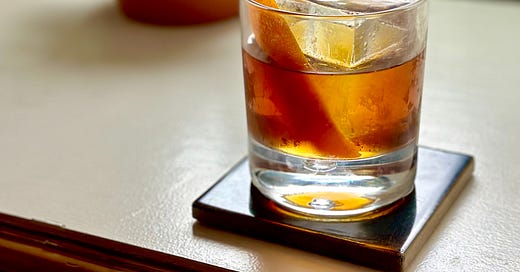The Apple Brandy-Cynar-Bénédictine Challenge
A lesson in creating — and fixing — original cocktails.
In this newsletter, I have written the following columns:
So it stands to reason that it should be possible to craft a delicious cocktail that combines all three ingredients — and ideally, only those three ingredients.
Indeed, as I was working on the recent newsletter about Bénédictine, I realized that it was incumbent upon me to produce such a drink. And so I gave myself an assignment — call it the Apple Brandy-Cynar-Bénédictine Challenge.
When I started working on this project, I assumed this would be pretty easy. It was not as easy as I expected.
Although the final recipe is, in fact, quite straightforward, my initial efforts to make a cocktail that combined these ingredients were not as productive as I’d hoped. My rough drafts were all just-OK, not-good-enough cocktails that tried to bind these three ingredients with some other element.
Eventually, however, I managed to design a delicious, pleasingly balanced, easy-to-make cocktail using just the three primary ingredients. The trick, it turned out, was to reorient my initial overarching idea for the drink’s structure. By discarding my starting assumptions and altering the baseline cocktail template I was working with, I was able to produce a much better drink.
So for this week’s newsletter, I want to take you through my process for creating this drink.
We’ll start with the initial framework I chose, and then we’ll look at some drink recipes that didn’t quite work, and how I tried to fix them.
We’ll also talk about why those recipes didn’t work, which, if nothing else, will give you, dear readers, a sense of the sort of cocktail I think is close but not good enough. (If you want to know what good is, it’s useful to have an understanding of what not-good-enough is.) And then at the end, we’ll look at the final recipe I settled on — one that does work, and what makes the difference.
Making a List, Checking It Twice
With projects like this, I tend to find that it’s useful to begin with an inventory of elements and their basic characteristics. So let’s start with what we know:
Apple brandy — specifically the Laird’s Straight Bottled-in-Bond that I use as my go-to American apple brandy — is most commonly used in cocktails as base spirit. It can sometimes substitute for other aged, brown spirits like whiskey or cognac.
Bénédictine is a sweet, spiced liqueur that can serve as both a flavor modifier (in drinks like the Vieux Carré) and a primary sweetener (in drinks like the Monte Carlo).
Cynar is a bittersweet amaro with an earthy, vegetal undertone that goes very well with apple brandy. It’s often used in the Campari slot in Negroni-esque drinks, but it can also substitute for dasher-bottle bitters, as in drinks like the Bensonhurst, a Manhattan riff that uses Cynar instead of Angostura bitters.



